Robert Powell reviewed recent testing he completed on a 99.88% pure magnesium sample first obtained in the Ubatuba region of Brazil in 1957. Powell also reviewed the history of the sample, previous chemical testing, isotopic analysis of the magnesium as well as isotopic analysis of impurities in the sample that were in 100ppm levels, namely strontium, barium, zinc, and copper. Lastly he discussed the meaning of the results that he obtained. For more information about the SCU visit: https://www.explorescu.org/
Blog
Borderland Science & UFOs
By Charles Lear
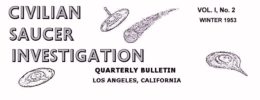 What was the first civilian organization solely dedicated to research on the subject of UFOs and when did they form? After a little research, most should agree that it was the Los Angeles based Civilian Saucer Investigation formed in 1951. What may surprise many is that there was a group interested in all things paranormal that was looking at aerial phenomena reports even before the June 24, 1947 Kenneth Arnold sighting. What may be equally surprising is the longevity of the organization, which started in 1945 and is still represented by an active website today.
What was the first civilian organization solely dedicated to research on the subject of UFOs and when did they form? After a little research, most should agree that it was the Los Angeles based Civilian Saucer Investigation formed in 1951. What may surprise many is that there was a group interested in all things paranormal that was looking at aerial phenomena reports even before the June 24, 1947 Kenneth Arnold sighting. What may be equally surprising is the longevity of the organization, which started in 1945 and is still represented by an active website today.
Borderland Sciences Research Associates was formed in San Diego, California in 1945 by Meade Layne along with fellow intellectuals interested in exploring subjects that lay between the realms of spiritualism and science. Layne was an academic with a masters in English who supported his family as a teacher, taking jobs across the country. In the course of his career, he was the English Department Head at Illinois Wesleyan University and Florida Southern College and a professor at the University of Southern California. Prior to his involvement with BSRA he had contributed various writings and research papers to journals devoted to parapsychology, spiritualism and the occult. As soon as the group was formed they published their own monthly newsletter, the Round Robin, and Layne was the editorial director. The subjects that were written about covered the range of what can be best described as “Western esotericism.”
In the January, 1946 issue we get the first story of interest for UFO historians. In an article titled, “Do You Hear Voices?” the writer addresses the “Shaver Mystery” which involved a man who heard voices while welding and believed them to be from degenerated humanoids living underground who flew through tunnels in technically advanced vehicles. These vehicles were later thought by some to be responsible for Arnold’s sighting and those that followed. This was likely due, in large part, to the influence of the men responsible for the mystery: writer, Richard Shaver and publisher, Ray Palmer. What may be of equal interest to UFO enthusiasts are comments taken from a letter in that same issue regarding ball lightning and “will-o’-the-wisps” mentioning marsh gas being a common prosaic explanation offered for strange lights. Read more
Declassified Pentagon Videos Explained
Just published for Den of Geek, Alejandro Rojas sat down with army veteran Colonel John Alexander and author Robert Powell to break down the Department of Defense’s recently declassified UFO videos, now formerly released by the Pentagon
UFO Crash in Aztec New Mexico
By Charles Lear
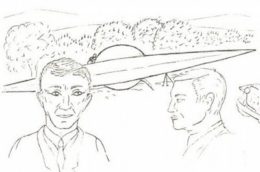 It often occurs among UFO enthusiasts that people will form a belief in a case and find it difficult to let go of that belief in spite of evidence that the case was more than likely a hoax. The alleged 1948 crash and retrieval of a flying disk near Aztec, New Mexico is a classic example. This case has spawned the well-known 1950 book by Frank Scully, “Behind the Flying Saucers”, two books that gave it new life, one in 1986 and one in 2011, and two extraordinary articles in True magazine that should serve as a model for investigative journalism.
It often occurs among UFO enthusiasts that people will form a belief in a case and find it difficult to let go of that belief in spite of evidence that the case was more than likely a hoax. The alleged 1948 crash and retrieval of a flying disk near Aztec, New Mexico is a classic example. This case has spawned the well-known 1950 book by Frank Scully, “Behind the Flying Saucers”, two books that gave it new life, one in 1986 and one in 2011, and two extraordinary articles in True magazine that should serve as a model for investigative journalism.
Things got rolling on March 8, 1950 with a lecture at the University of Denver on the subject of flying saucers. The lecturer spoke before a large group of students and remained anonymous for alleged security reasons. He was originally chosen to provide a Basic Science class studying critical thinking something to work with but the word got out and, due to popular demand, it was necessary to move the lecture to a larger hall. The man started with some background history, speculated that the craft were operated using magnetic propulsion and then mentioned that there had been four crashes and retrievals in America and a fifth in Africa. A local paper wrote an article about the lecture and the hunt was on for the lecturer’s identity. It was eventually discovered that the man in question was Silas P. Newton, who represented himself as a prominent geophysicist and businessman in the oil industry. He happened to be a friend of Frank Scully, who was a writer for Variety, and Scully realized that he had a good story on his hands. He talked with Newton who introduced him to a colleague who would be referred to only as “Dr. Gee” by Scully and the result was “Behind the Flying Saucers” published in September of that year. It was in this book that details of the Aztec crash and retrieval were made public to a wide audience and a case was born that refuses to die in spite of evidence that the event in question never happened.
The Socorro UFO Investigation
By Charles Lear
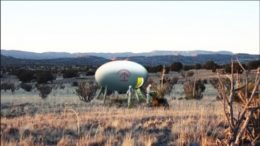 The April 24, 1964 sighting of a landed UFO with two beings standing next to it by Socorro, NM Police Sergeant, Lonnie Zamora has been written about extensively and remains a fascinating mystery to this day. What’s particularly interesting about this case is how many people investigated it. Representatives from the Socorro Police, New Mexico State Police the F.B.I. and Army were first on the scene followed by the Lorenzens from the Aerial Phenomena Research Organization, members of the Air Force and J. Allen Hynek as part of Project Blue Book, and Ray Stanford for the National Investigations Committee on Aerial Phenomena. Besides the testimony of Zamora, there was trace evidence to examine, witnesses to a similar craft to interview, and reputed witnesses to the very craft Zamora reported who were searched for but never found. Despite the thoroughness of the inquiries and analyses by so many experienced investigators, no one was able to come up with an agreeable Earthly explanation.
The April 24, 1964 sighting of a landed UFO with two beings standing next to it by Socorro, NM Police Sergeant, Lonnie Zamora has been written about extensively and remains a fascinating mystery to this day. What’s particularly interesting about this case is how many people investigated it. Representatives from the Socorro Police, New Mexico State Police the F.B.I. and Army were first on the scene followed by the Lorenzens from the Aerial Phenomena Research Organization, members of the Air Force and J. Allen Hynek as part of Project Blue Book, and Ray Stanford for the National Investigations Committee on Aerial Phenomena. Besides the testimony of Zamora, there was trace evidence to examine, witnesses to a similar craft to interview, and reputed witnesses to the very craft Zamora reported who were searched for but never found. Despite the thoroughness of the inquiries and analyses by so many experienced investigators, no one was able to come up with an agreeable Earthly explanation.
 According to Zamora’s written report, he was chasing a speeder around 5:45 PM in the southeast section of Socorro when he heard what he described as a roar and saw a flame to the southwest. Just over a nearby hill was a dynamite shack and Zamora was concerned that it might have blown up, so he broke pursuit and went to investigate. As he drove he saw a funnel shaped, narrower at the top, blue and “sort of orange” flame slowly descend behind the hill. He turned onto a dirt road, made it up a hill after three tries, and, after looking around for 15-20 seconds, saw what he thought was a car standing on end in a gully. As he got closer he noted two figures in what looked like white coveralls standing next to the “car” and as he drove quickly towards them to help, one of the figures turned towards him and seemed startled. Zamora was focused on the road and radioed that there had been an accident. When he was close to the site, he went to get out of the car and dropped the mic as he was doing so. He turned to replace it in its holder and, as soon as he turned away from the car to head down into the gully, he heard a roar, and saw flame coming out of the bottom of a white object shaped like an oval on its side, which was rising up slowly. He described the roar as not being like a jet, going from lower pitch to higher pitch and increasing “from loud to very loud.” During this time he noted a red insignia like an arrow under a crescent in the middle of the object. Fearful of an explosion, Zamora ran behind his car, bumping his leg on it and dropping his sun glasses, and kept on running to duck down just over the edge of the hill. He glanced back at the object as he did so and saw that it was completely out of the gully and level with his car. He had intended to keep running down the hill when the roar stopped and was replaced by a whine that went from high to low pitch for about a second. The object then moved away towards the southwest in complete silence, with no flame, in a straight line maintaining a height of 10-15 feet, which Zamora estimated in relation to the dynamite shack, which it had cleared by around 3 feet. According to Zamora the object moved quickly away and then ascended as it took off “across country.” Zamora later recalled seeing legs when the object was landed, that held it about three feet off the ground. Most likely, as he was thinking he was looking at a crashed car at the time, he was unable to put what he was seeing into a proper context. He radioed headquarters and asked the operator, Nep Lopes to look out his window and tell him if he could see what he was looking at. Lopes saw nothing and Zamora gave directions to him and Sergeant Sam Chavez of the State Police who monitored the same frequencies as the Socorro Police.
According to Zamora’s written report, he was chasing a speeder around 5:45 PM in the southeast section of Socorro when he heard what he described as a roar and saw a flame to the southwest. Just over a nearby hill was a dynamite shack and Zamora was concerned that it might have blown up, so he broke pursuit and went to investigate. As he drove he saw a funnel shaped, narrower at the top, blue and “sort of orange” flame slowly descend behind the hill. He turned onto a dirt road, made it up a hill after three tries, and, after looking around for 15-20 seconds, saw what he thought was a car standing on end in a gully. As he got closer he noted two figures in what looked like white coveralls standing next to the “car” and as he drove quickly towards them to help, one of the figures turned towards him and seemed startled. Zamora was focused on the road and radioed that there had been an accident. When he was close to the site, he went to get out of the car and dropped the mic as he was doing so. He turned to replace it in its holder and, as soon as he turned away from the car to head down into the gully, he heard a roar, and saw flame coming out of the bottom of a white object shaped like an oval on its side, which was rising up slowly. He described the roar as not being like a jet, going from lower pitch to higher pitch and increasing “from loud to very loud.” During this time he noted a red insignia like an arrow under a crescent in the middle of the object. Fearful of an explosion, Zamora ran behind his car, bumping his leg on it and dropping his sun glasses, and kept on running to duck down just over the edge of the hill. He glanced back at the object as he did so and saw that it was completely out of the gully and level with his car. He had intended to keep running down the hill when the roar stopped and was replaced by a whine that went from high to low pitch for about a second. The object then moved away towards the southwest in complete silence, with no flame, in a straight line maintaining a height of 10-15 feet, which Zamora estimated in relation to the dynamite shack, which it had cleared by around 3 feet. According to Zamora the object moved quickly away and then ascended as it took off “across country.” Zamora later recalled seeing legs when the object was landed, that held it about three feet off the ground. Most likely, as he was thinking he was looking at a crashed car at the time, he was unable to put what he was seeing into a proper context. He radioed headquarters and asked the operator, Nep Lopes to look out his window and tell him if he could see what he was looking at. Lopes saw nothing and Zamora gave directions to him and Sergeant Sam Chavez of the State Police who monitored the same frequencies as the Socorro Police.
Comic Relief by UFO Filmmaker, Dean Alioto & Ali
For a little fun to relieve the stress, filmmaker Dean Alioto and his girlfriend Ali made a video for all the fellow quarantines out there who need a good laugh.
Check out his website: www.deanalioto.com
UFOs and the Aerial Phenomena Research Organization
By Charles Lear
For most of the modern UFO era, those interested in the subject have depended on private groups for information. The most prominent and enduring of these is the Mutual UFO Network. What many may not know is that MUFON came about as an offshoot of an extraordinary group called the Aerial Phenomena Research Organization that was a mom and pop operation for much of its existence.
 APRO was formed in the fall of 1951 through the efforts of Coral Lorenzen with the help and encouragement of her husband, Jim. Coral’s interest in UFOs preceded the 1947 Kenneth Arnold sighting by more than a decade following her own sighting of an unexplained object. Coral claimed that in 1934, as a young girl with the maiden name, Lightner, she and her two playmates, Barbara Stringer and Dorothy Wethern, saw what looked like a parachute moving across the sky. Coral noticed that it didn’t have any strings and this caused her to question whether what she was seeing actually was a parachute. She told her father what she had seen and he was impressed enough to make inquiries and found that there were no pilots in the area at that time. Three years later, at the age of 12, Coral was being checked for astigmatism and told her doctor what she had seen. He recommended that she read the books of Charles Fort, a writer who was a pioneer chronicler of the strange and unusual, and Coral developed an interest that would stick with her for the rest of her life.
APRO was formed in the fall of 1951 through the efforts of Coral Lorenzen with the help and encouragement of her husband, Jim. Coral’s interest in UFOs preceded the 1947 Kenneth Arnold sighting by more than a decade following her own sighting of an unexplained object. Coral claimed that in 1934, as a young girl with the maiden name, Lightner, she and her two playmates, Barbara Stringer and Dorothy Wethern, saw what looked like a parachute moving across the sky. Coral noticed that it didn’t have any strings and this caused her to question whether what she was seeing actually was a parachute. She told her father what she had seen and he was impressed enough to make inquiries and found that there were no pilots in the area at that time. Three years later, at the age of 12, Coral was being checked for astigmatism and told her doctor what she had seen. He recommended that she read the books of Charles Fort, a writer who was a pioneer chronicler of the strange and unusual, and Coral developed an interest that would stick with her for the rest of her life.
By 1947, Coral had married Leslie James Lorenzen and had become an amateur astronomer. On June 10th, two weeks before Arnold’s sighting, Coral claimed to have seen a light appear next to a mountain in Mexico while looking for meteors from her back porch in Douglas, Arizona. In her words, “It became a tiny ball of light, then suddenly shot up into the sky, eventually disappearing at nearly zenith. After Arnold’s sighting of nine objects flying in formation over Mount Ranier, “flying saucer” sightings became big news and Coral began clipping and saving articles.
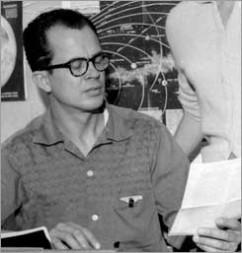 In 1951, Coral and Jim Lorenzen were living in Sturgeon Bay, Wisconsin after a brief stay in Los Angeles. While in Los Angeles, they had met contactee, George Adamski, and Coral reported that she was unimpressed by his claims, in part due to his repeated references to the moon as a planet. In Wisconsin, Coral decided to start a group that would keep track of sightings reports and she wrote to people she knew who might be interested. Around fifty responded positively and the Aerial Phenomena Research Organization came to be. Coral had chosen the name, consciously avoiding the term, “flying saucers” which she found distasteful. The center of operation for APRO was an antique table with clawed feet in the corner of the Lorenzen’s living room and the means of communication among its members was a portable typewriter.
In 1951, Coral and Jim Lorenzen were living in Sturgeon Bay, Wisconsin after a brief stay in Los Angeles. While in Los Angeles, they had met contactee, George Adamski, and Coral reported that she was unimpressed by his claims, in part due to his repeated references to the moon as a planet. In Wisconsin, Coral decided to start a group that would keep track of sightings reports and she wrote to people she knew who might be interested. Around fifty responded positively and the Aerial Phenomena Research Organization came to be. Coral had chosen the name, consciously avoiding the term, “flying saucers” which she found distasteful. The center of operation for APRO was an antique table with clawed feet in the corner of the Lorenzen’s living room and the means of communication among its members was a portable typewriter.
UFOs and Balloons
by Charles Lear
That UFO sightings, more often than not, have prosaic explanations should surprise no one. Whether or not an explanation is accepted by witnesses and believers is another question.
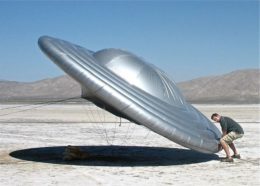 An important factor influencing acceptance is the credibility of the investigator. It should be safe to say at.this point that civilian UFO investigators have more credibility than government employed investigators. This is because, far too often, commonly mistaken objects have been indiscriminately offered as explanations by public officials in order to put a case to rest. This is unfortunate because there are occasions where a good solution to a case that could help clear out some of noise in the signal may be dismissed by many due to what has become a reflexive reaction. From a list that seems logical, here are the most commonly misidentified objects listed from 1-7: military experiments, airplanes, Venus, balloons, weird cloud formations, missile tests and lightning. Of these, Venus and balloons are the most infamous of abused identification choices but balloons, particularly weather balloons, have been a sore spot for civilian researchers and witnesses since the early days of the modern, post 1947, UFO era.
An important factor influencing acceptance is the credibility of the investigator. It should be safe to say at.this point that civilian UFO investigators have more credibility than government employed investigators. This is because, far too often, commonly mistaken objects have been indiscriminately offered as explanations by public officials in order to put a case to rest. This is unfortunate because there are occasions where a good solution to a case that could help clear out some of noise in the signal may be dismissed by many due to what has become a reflexive reaction. From a list that seems logical, here are the most commonly misidentified objects listed from 1-7: military experiments, airplanes, Venus, balloons, weird cloud formations, missile tests and lightning. Of these, Venus and balloons are the most infamous of abused identification choices but balloons, particularly weather balloons, have been a sore spot for civilian researchers and witnesses since the early days of the modern, post 1947, UFO era.
 The July, 1947, headlines announced that the Air Force had recovered a “flying saucer.” At a press conference set up to address the story, which originated from an Air Force press release, a weather balloon was displayed and the press was told that it was this that was recovered. The press and public accepted the explanation until researcher, Stanton Friedman, investigated the case beginning in 1978 and found discrepancies and evidence of a cover up. The case gained so much notoriety, that New Mexico Congressman, Steven Schiff was moved to pressure the General Accounting Office for Air Force records related to the event. The Air Force took it upon themselves to investigate and, in 1995 released “Roswell Report: Fact vs. Fiction in the New Mexico Desert.” The authors of this 1000 page report came to the conclusion that what was recovered was not a weather balloon but a string of balloons that were part of a developing top secret project. The project was named, ”Project Mogul” and its purpose was to detect Soviet nuclear weapons tests. The report failed to convince most of those who adhered to the extraterrestrial cash theory.
The July, 1947, headlines announced that the Air Force had recovered a “flying saucer.” At a press conference set up to address the story, which originated from an Air Force press release, a weather balloon was displayed and the press was told that it was this that was recovered. The press and public accepted the explanation until researcher, Stanton Friedman, investigated the case beginning in 1978 and found discrepancies and evidence of a cover up. The case gained so much notoriety, that New Mexico Congressman, Steven Schiff was moved to pressure the General Accounting Office for Air Force records related to the event. The Air Force took it upon themselves to investigate and, in 1995 released “Roswell Report: Fact vs. Fiction in the New Mexico Desert.” The authors of this 1000 page report came to the conclusion that what was recovered was not a weather balloon but a string of balloons that were part of a developing top secret project. The project was named, ”Project Mogul” and its purpose was to detect Soviet nuclear weapons tests. The report failed to convince most of those who adhered to the extraterrestrial cash theory.
Faded Discs, Vintage UFO Encounter Interviews
 The UFO mystery is not a 20th century phenomenon, but it did in many ways come into prominence in the 20th century. Serious study of UFOs began around World War II and thrived in the following decades. During this golden age of UFO study radio was the dominant form of electronic media. Although film and television existed, radio was a much more important source of timely news and information. Also during this time UFO investigators would find audio recording devices much more portable, reliable and affordable than film equipment. All of this led to an incredible amount of information from the golden age of UFO study being stored in audio formats.
The UFO mystery is not a 20th century phenomenon, but it did in many ways come into prominence in the 20th century. Serious study of UFOs began around World War II and thrived in the following decades. During this golden age of UFO study radio was the dominant form of electronic media. Although film and television existed, radio was a much more important source of timely news and information. Also during this time UFO investigators would find audio recording devices much more portable, reliable and affordable than film equipment. All of this led to an incredible amount of information from the golden age of UFO study being stored in audio formats.UFOs and the Predicted Death of Frank Edwards
by Charles Lear
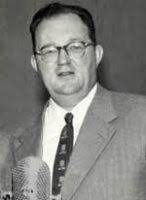 Was the death of Frank Edwards, famous newscaster and UFOlogist, predicted by the space people? This story shows up in a lot of literature from the time and many people took it seriously. An additional oddity offered up in the account is that the time of Edward’s death was a few hours before midnight, June 23rd, 1967. This was almost twenty years to the day after June 24, 1947, which was the date of the sighting by Kenneth Arnold that many consider the beginning of the modern UFO mystery.
Was the death of Frank Edwards, famous newscaster and UFOlogist, predicted by the space people? This story shows up in a lot of literature from the time and many people took it seriously. An additional oddity offered up in the account is that the time of Edward’s death was a few hours before midnight, June 23rd, 1967. This was almost twenty years to the day after June 24, 1947, which was the date of the sighting by Kenneth Arnold that many consider the beginning of the modern UFO mystery.
The story begins in New York City during the 1967 Congress of Scientific UFOlogists. It was billed as “New York’s first flying saucer convention” and took place over a weekend starting Friday, June 23rd and ending Sunday, June 25th. The chairman of the event was Jim Moseley and speakers included: Ivan Sanderson, John Keel, Frank Stranges, James Randi, Howard Menger Long John Nebel and Gray Barker. In the audience was Dr. Edward Condon, presumably researching for the Air Force funded University of Colorado UFO study. The organizers had arranged to have a court reporter, Bessie J. Gibbs present and a transcription of the entire convention was published and available for the price of five dollars.
UFOs on the Radio
By Charles Lear
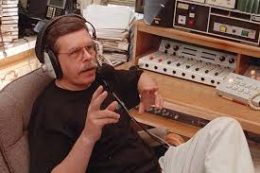 For many people, the late night radio show, “Coast to Coast AM” hosted by Art Bell, was their source for a steady stream of discussion on the subject of UFOs. It began in 1988 as a forum for political discussion with call-ins and interviews and, by 1995, it had evolved into a platform for the paranormal. Bell broadcast from his home in Pahrump, Nevada and handled five phone lines by himself putting unscreened call-in guests on the air to discuss strange experiences, conspiracy theories, UFOs and aliens. At its peak in the late 1990’s, the show was broadcast on over 500 stations and had an estimated 15 million listeners. Bell had discovered, and proven to others, that UFOs and the paranormal could be big business in broadcasting but, as would be expected given the long history of radio, he wasn’t the first.
For many people, the late night radio show, “Coast to Coast AM” hosted by Art Bell, was their source for a steady stream of discussion on the subject of UFOs. It began in 1988 as a forum for political discussion with call-ins and interviews and, by 1995, it had evolved into a platform for the paranormal. Bell broadcast from his home in Pahrump, Nevada and handled five phone lines by himself putting unscreened call-in guests on the air to discuss strange experiences, conspiracy theories, UFOs and aliens. At its peak in the late 1990’s, the show was broadcast on over 500 stations and had an estimated 15 million listeners. Bell had discovered, and proven to others, that UFOs and the paranormal could be big business in broadcasting but, as would be expected given the long history of radio, he wasn’t the first.
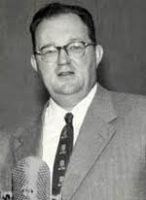 Near the end of the year 1949, Frank Edwards, newscaster for the American Federation of Labor sponsored Mutual Broadcasting System, received an advance copy of the January, 1950 edition of True Magazine. Edward’s attention was captured by a, now historic, article by Donald E. Keyhoe, “The Flying Saucers Are Real.” Edwards got permission from the editor to break the story on air and from that moment on, continued to include UFO reports and other stories of Forteana in his broadcasts. Though not proven, it is quite likely that these new reports and stories were a great help in propelling Edward’s show to become one of the top three radio news shows in early ‘50s America. He left MBS in 1954 and, shortly thereafter, created and hosted a syndicated radio show called, “Stranger Than Fiction” which was fully devoted to Forteana and UFOs. Edwards is best known to UFOlogists as the author of the 1966 classic, “Flying Saucers – Serious Business.” Edward’s new radio show was short-lived but another broadcaster came up with a show of his own that would go on for many years with great success.
Near the end of the year 1949, Frank Edwards, newscaster for the American Federation of Labor sponsored Mutual Broadcasting System, received an advance copy of the January, 1950 edition of True Magazine. Edward’s attention was captured by a, now historic, article by Donald E. Keyhoe, “The Flying Saucers Are Real.” Edwards got permission from the editor to break the story on air and from that moment on, continued to include UFO reports and other stories of Forteana in his broadcasts. Though not proven, it is quite likely that these new reports and stories were a great help in propelling Edward’s show to become one of the top three radio news shows in early ‘50s America. He left MBS in 1954 and, shortly thereafter, created and hosted a syndicated radio show called, “Stranger Than Fiction” which was fully devoted to Forteana and UFOs. Edwards is best known to UFOlogists as the author of the 1966 classic, “Flying Saucers – Serious Business.” Edward’s new radio show was short-lived but another broadcaster came up with a show of his own that would go on for many years with great success.
UFOs and Humanoids in 1973
By Charles Lear
 The decade of the 1970’s was a strange one in America. The counter-culture of the late 50’s gained momentum through the 60’s and, by the 70’s, it had gone mainstream. Experimentation was everywhere in the arts, culture and politics of the era and the minds of the general population were open to possibilities that were, perhaps, beyond the capabilities of the science of the day to explain. It was a good time for UFOlogy and many documentaries on the subject started to appear in movie theaters that culminated in Steven Spielberg’s 1977 fictional treatment, “Close Encounters of the Third Kind.” The title of the movie comes from J. Allen Hynek’s system of sightings classification and CE3 designated a UFO sighting that involved beings. In 1973, CE3 sightings hit a peak and that year was designated, “The Year of the Humanoids” in a report published by the Center for UFO Studies, written by David Webb from files provided by Ted Bloecher. Both men were co-chairman for the Mutual UFO Network associated, Humanoid Study Group.
The decade of the 1970’s was a strange one in America. The counter-culture of the late 50’s gained momentum through the 60’s and, by the 70’s, it had gone mainstream. Experimentation was everywhere in the arts, culture and politics of the era and the minds of the general population were open to possibilities that were, perhaps, beyond the capabilities of the science of the day to explain. It was a good time for UFOlogy and many documentaries on the subject started to appear in movie theaters that culminated in Steven Spielberg’s 1977 fictional treatment, “Close Encounters of the Third Kind.” The title of the movie comes from J. Allen Hynek’s system of sightings classification and CE3 designated a UFO sighting that involved beings. In 1973, CE3 sightings hit a peak and that year was designated, “The Year of the Humanoids” in a report published by the Center for UFO Studies, written by David Webb from files provided by Ted Bloecher. Both men were co-chairman for the Mutual UFO Network associated, Humanoid Study Group.
Webb wrote that from August into December of 1973, there were 70 reports in files available to him of humanoids associated with UFOs, with 55 of them being within the continental United States. These sorts of reports have always made up a small percentage of the overall reports and Webb acknowledged this. He went on to consider that, if one was to assume that UFOs are piloted extraterrestrial crafts visiting Earth, more could be learned about the visitors by studying them than studying the crafts. The first step, as he saw it, was to organize the sightings. Humanoids seen in association with craft were of primary interest followed by those seen in the proximity of UFO activity. Webb mentions contactee reports with caution, “monster” sightings and finally abduction reports. He distinguished humanoids from “monsters” and ape-like creatures such as Bigfoot, which he termed, “anthropoids.”
When UFOs Were Flying Saucers
By Charles Lear
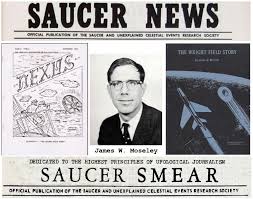 In the early days of the modern UFO era, if you were an American and you saw something strange in the sky and wanted someone to investigate, you reported it to the Air Force. If the Air Force dismissed your case as unworthy of study before 1952, there were no other organizations to turn to. There were a few private individuals who might be willing to look into it, but they were usually under contract with publications such as True Magazine, Look Magazine, and Fate, which meant that there would be some publicity involved. There was a need for a private organization of dedicated researchers and, by the end of 1952, three groups had formed to fill it. The first two were the International Flying Saucer Bureau founded by Albert K. Bender, based in Connecticut and Civilian Saucer Investigation, a Los Angeles based group. IFSB had Gray Barker, an imaginative writer, as its chief investigator while CSI was founded by North American Aviation engineer, Edward J. Sullivan and had, as one of its investigators, Walther Riedel, one of the V-2 creators who had come to America as part of operation paperclip. The third group was The Aerial Phenomena Research Organization started in January, 1952 by Jim And Coral Lorenzen. Both IFSB and CSI had ceased operations by 1954, while APRO continued until 1988. In 1954, an organization was formed in New York City called, Civilian Saucer Intelligence New York by Alexander Mebane, Isabel Davis, and Ted Bloecher, who held CSI-LA in high regard. CSI-NY is notable, not only for the caliber of their primary researchers but also, for their association with the biggest names in early saucer and paranormal research. They would also have a huge impact on UFOlogy with their assistance to a young J. Allen Hynek. Hynek, as a consultant for the Air Force’s Project Blue Book was, discretely, seeking outside help in the midst of what he felt was a less than earnest attempt by the Air Force to get to the root of the mystery. The group lasted for five years and shortened the name to Civilian Saucer Research in July of 1957. They did a lot of hard work researching and cataloguing sightings reports, held monthly meetings and published newsletters for their membership. Many of the publications were archived by the Center for UFO Studies and are available today on the CUFOS website. Reading through them, one is taken back to a time in UFOlogy when “flying saucer” was still the major term being used and some of its most colorful characters were just coming to public attention.
In the early days of the modern UFO era, if you were an American and you saw something strange in the sky and wanted someone to investigate, you reported it to the Air Force. If the Air Force dismissed your case as unworthy of study before 1952, there were no other organizations to turn to. There were a few private individuals who might be willing to look into it, but they were usually under contract with publications such as True Magazine, Look Magazine, and Fate, which meant that there would be some publicity involved. There was a need for a private organization of dedicated researchers and, by the end of 1952, three groups had formed to fill it. The first two were the International Flying Saucer Bureau founded by Albert K. Bender, based in Connecticut and Civilian Saucer Investigation, a Los Angeles based group. IFSB had Gray Barker, an imaginative writer, as its chief investigator while CSI was founded by North American Aviation engineer, Edward J. Sullivan and had, as one of its investigators, Walther Riedel, one of the V-2 creators who had come to America as part of operation paperclip. The third group was The Aerial Phenomena Research Organization started in January, 1952 by Jim And Coral Lorenzen. Both IFSB and CSI had ceased operations by 1954, while APRO continued until 1988. In 1954, an organization was formed in New York City called, Civilian Saucer Intelligence New York by Alexander Mebane, Isabel Davis, and Ted Bloecher, who held CSI-LA in high regard. CSI-NY is notable, not only for the caliber of their primary researchers but also, for their association with the biggest names in early saucer and paranormal research. They would also have a huge impact on UFOlogy with their assistance to a young J. Allen Hynek. Hynek, as a consultant for the Air Force’s Project Blue Book was, discretely, seeking outside help in the midst of what he felt was a less than earnest attempt by the Air Force to get to the root of the mystery. The group lasted for five years and shortened the name to Civilian Saucer Research in July of 1957. They did a lot of hard work researching and cataloguing sightings reports, held monthly meetings and published newsletters for their membership. Many of the publications were archived by the Center for UFO Studies and are available today on the CUFOS website. Reading through them, one is taken back to a time in UFOlogy when “flying saucer” was still the major term being used and some of its most colorful characters were just coming to public attention.